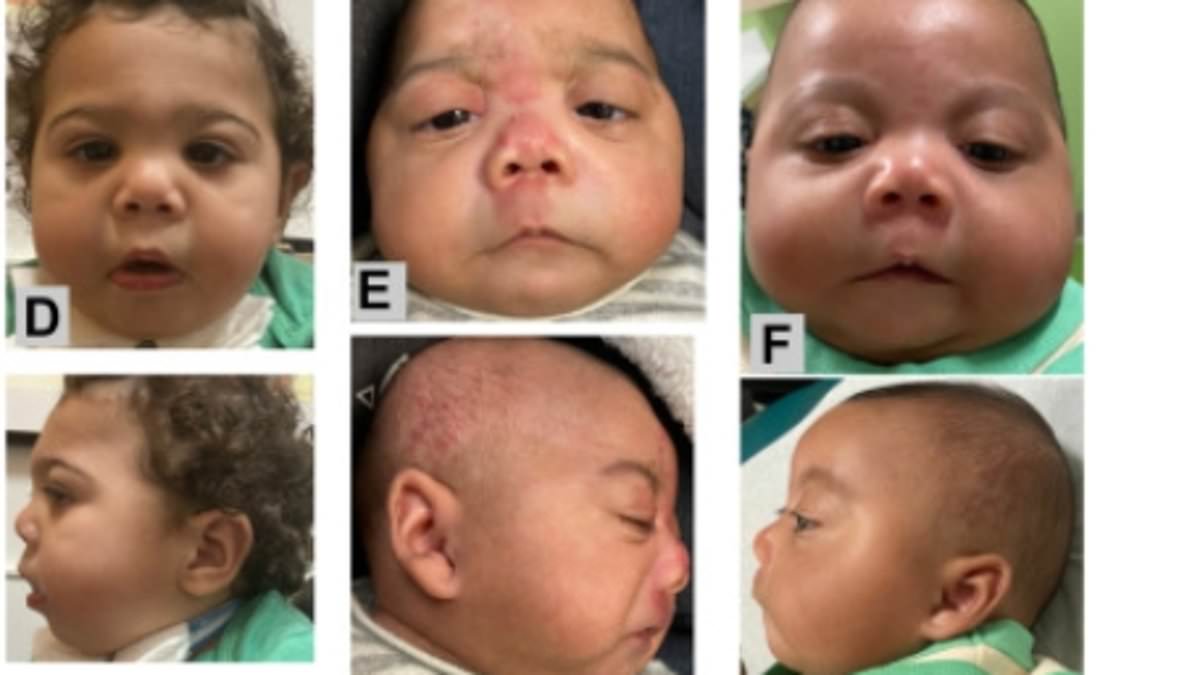Dozens more babies in the US have been born with a frightening new condition linked to fentanyl abuse during pregnancy.
Known as fetal fentanyl syndrome, the condition causes multiple physical and brain defects, including conjoined fingers and toes and deformed heads.
Dr Miguel Del Campo, at Rady Children’s Hospital in San Diego, has seen 20 babies with the condition and fears the issue is far more widespread and going undetected.
The syndrome was only identified last fall and there is no national or state-level data to track how prevalent it is.

In addition to having underdeveloped jaws, some of the babies also showed cleft palates
Dr Del Campo was inspired by that research, which was published by doctors from Vanderbilt University, the University of Nebraska Medical Center and Nemours Children’s Hospital in Delaware.
He said: ‘After reading the paper and thinking about things, I have recognized the potential for exposure to fentanyl.’
It is thought that fentanyl damages the baby’s ability to make cholesterol in the womb, a crucial for their brains to develop.
Babies with the syndrome often have a cleft palate, ‘rocker bottom feet’ – named for the way bent feet resemble the legs of a rocking chair – upturned noses, drooping eyelids, undersized lower jaws, and webbed toes.
Dr Del Campo told NBC News: ‘I have identified 20 patients’ with these characteristics.
‘I fear that this is not rare, and I fear kids are going unrecognized,’ Dr Del Campo added.
Fears that the number of cases could be an undercount is mounting as fentanyl becomes the leading cause of overdose deaths. Rates of deadly overdoses linked to fentanyl are at an all-time high, tripling from 2016 to 2021, rising from 5.7 per 100,000 persons in 2016 to 21.6 in 2021.
Fentanyl is increasingly used to adulterate other substances and hook users, who often don’t know they’re consuming fentanyl.

The babies found to be affected by maternal fentanyl use had smaller heads and underdeveloped jawbones overall
Further evidence is needed to prove without a doubt that fentanyl is the cause of these birth defects, which is not yet settled scientific fact.
The National Institutes of Health, for instance, said just two years ago that, ‘Based on the studies reviewed, exposure to fentanyl is not expected to increase the chance for birth defects above the background risk.’
Fentanyl passes through the placenta, the organ that develops during pregnancy which provides oxygen and nutrients for the fetus.
Researchers identified a previous study that had found ‘fentanyl in fetal brain tissue, concluding that there is rapid transfer of fentanyl to the fetus in early pregnancy and that the drug remains in fetal tissue for some time.’
But the NIH has said that ‘studies have not found a specific pattern of birth defects caused by opioids’ and can’t conclude that fentanyl causes these effects.

Some of the babies also had broader thumbs than what is normally seen as well as a single horizontal crease on their palms as opposed to the normal two

Several babies had conjoined toes and rounded ‘rocker bottom’ feet
Last year, Delaware-based pediatricians with researchers identified 10 babies with the defects in their state, as well as in California, Boston, and Rhode Island, believed to be suffering from fetal fentanyl syndrome. The study was separate from the one led by Vanderbilt scientists.
There had not been an established link between cholesterol production and these symptoms until Vanderbilt scientists began probing the possible causes.
They analyzed the similarities between fetal fentanyl syndrome and a genetic disorder called Smith-Lemli-Opitz Syndrome (SLOS), caused when a person has two genes that impair the body’s ability to make cholesterol.
They discovered that when a fetus has just one of those genes, though, they are much more susceptible to these birth defects linked to fentanyl exposure in utero.
Ned Porter, research professor of chemistry at Vanderbilt, said: ‘Fentanyl not only impairs the synthesis of cholesterol, but it also leads to the build-up of the same highly toxic sterols in cells that are found in SLOS patients.
‘It seems likely that the presence of this compound during fetal development plays a large part in these syndromes.’










